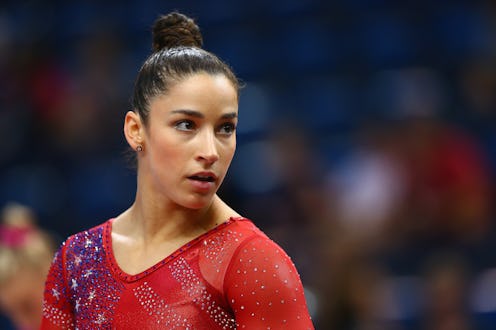Life
Olympic Athletes Eat This Many Calories In A Day
When the rumor started going around that Michael Phelps was eating 12,000 calories a day to prepare for the 2008 Olympics, we didn't know if we should induct him into some kind of Hall of Fame or be slightly disgusted. We wonder what Olympic athletes eat, how much they eat, and how often they eat, but because we have an idea of how much strenuous physical activity they take on, we know one thing for sure: Olympic athletes have to eat more calories than the rest of us if they have any chance at making it through the day. The million dollar question, though, is just how many calories they consume a day.
As captivating of a story Phelps and his 12,000 calories makes, you'll be sorely disappointed if you think that's the norm. (Not that any of us ever thought the 5'2 tall gymnasts were chucking back that much food anyway.) The truth is, the answer to this question varies across the board depending on the athlete's sport and body size, so it's hard to give one definitive answer as to how many calories all the Olympians are eating a day.
"Athletes' needs all depend on their genetics, size, goals and activity level,” Brian St. Pierre, MS, RD, sports dietitian at Precision Nutrition, tells Experience Life. The more intense and lengthy the sport is, the more they need to eat in order to replenish their bodies and help them recover from their tough training sessions.
Endurance athletes, such as swimmers, cyclists, rowers, and marathon runners, take the cake for most calories generally eaten in a day. They're known to toss back up to 8,000 or 9,000 calories in a 24-hour period. That may sound like an unpleasantly hefty amount of food, but Olympic swimmers burn between 3,000 and 10,000 calories each day when they're training for events, so for some of them, eating 8,000 calories would actually put them in calorie deficit. It's no wonder Phelps was able to stomach 12,000 calories so easily.
However, these numbers are at the extreme end of the spectrum. Basketball players, soccer players, and tennis players eat between 3,000 to 4,500 calories in a day. Their level of activity is very rigorous, undoubtedly, but they're not quite putting out as much effort and energy as the endurance athletes, so they can afford to consume a lot less, in some cases half of what the swimmers devour.
The so-called "aesthetic sports" — gymnastics, synchronized swimming, diving — require a moderate number of calories by comparison. Gymnast champions like Aly Raisman and Gabby Douglas consume somewhere between 2,000 and 2,500 calories a day. That's not to say they're working any less hard than the marathon runners who burn and eat double the amount of calories — rather, their sport simply requires a different kind of physicality.
Nanna Meyer, senior sport dietitian for the U.S. Olympic Committee and a professor of sports nutrition at the University of Colorado, told NPR that the sport of gymnastics requires the athletes to stop and go, stop and go, over and over again. Compare that to the long-winded sessions that sports like cycling and swimming require, which call for the athlete to be active for extended periods of time with no breaks, and you'll understand why they don't need to beef up on the calories in the same way that U.S. swimmer and five-time Olympic medalist Missy Franklin may have to, for example.
For the strength and power sports, like weight lifting and shot put, you'll see the numbers of calories per day spike up again, sitting right between what the gymnasts and swimmers are consuming. Weight lifters like Morghan King eat between 2,800 and 6,000 calories a day to replenish their body after the extremely taxing short bursts of energy it takes to pull off a hang snatch.
Meyer tells NPR that, although we like to think we have a solid idea of how many calories these athletes are taking in every day, we can't know for sure. "We don't have great data on many sports on energy expenditure because we can't measure it," she says. Besides, the numbers vary greatly between men and women, and between different body types. The above numbers are nothing more than rough guesstimates of what the Olympians are normally eating.
Of course, no matter what kind of Olympian athlete you are, it's not so much the number of calories you're trying to consume in a day, but the quality of them that truly matters. Although Ryan Lochte has been known to throw back Chicken McNuggets, Double Cheeseburgers, a Big Mac, and fries for dinner, he's since changed up his eating routine to cleaner foods in order to keep his athleticism at an optimal level. Now, he eats whole grain spaghetti and a few grilled chicken breasts with Alfredo sauce, and a big salad on the side.
So, at the end of the day, quality over quantity is the name of the calorie game for these incredible athletes. Kind of like it is for the rest of us.
Images: alyraisman, missyfranklin88, serenawilliams, kingmorghan/Instagram
